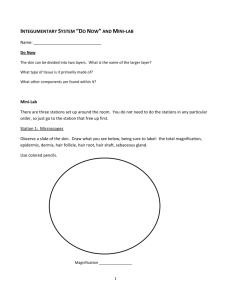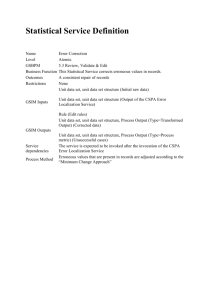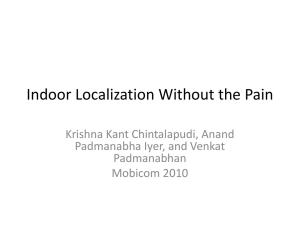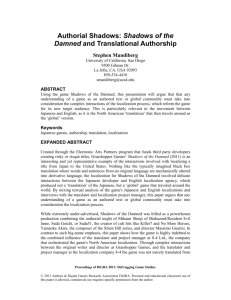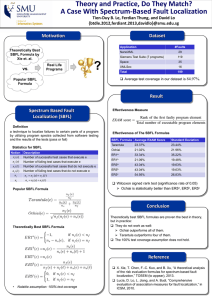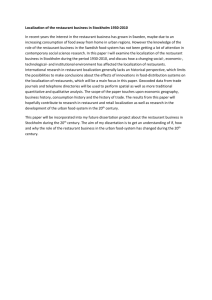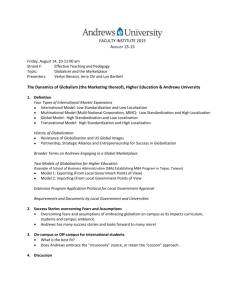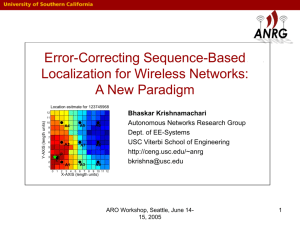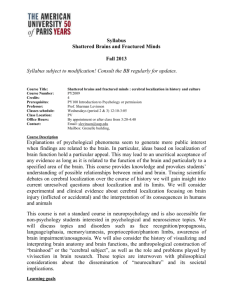Global English Skills:
advertisement
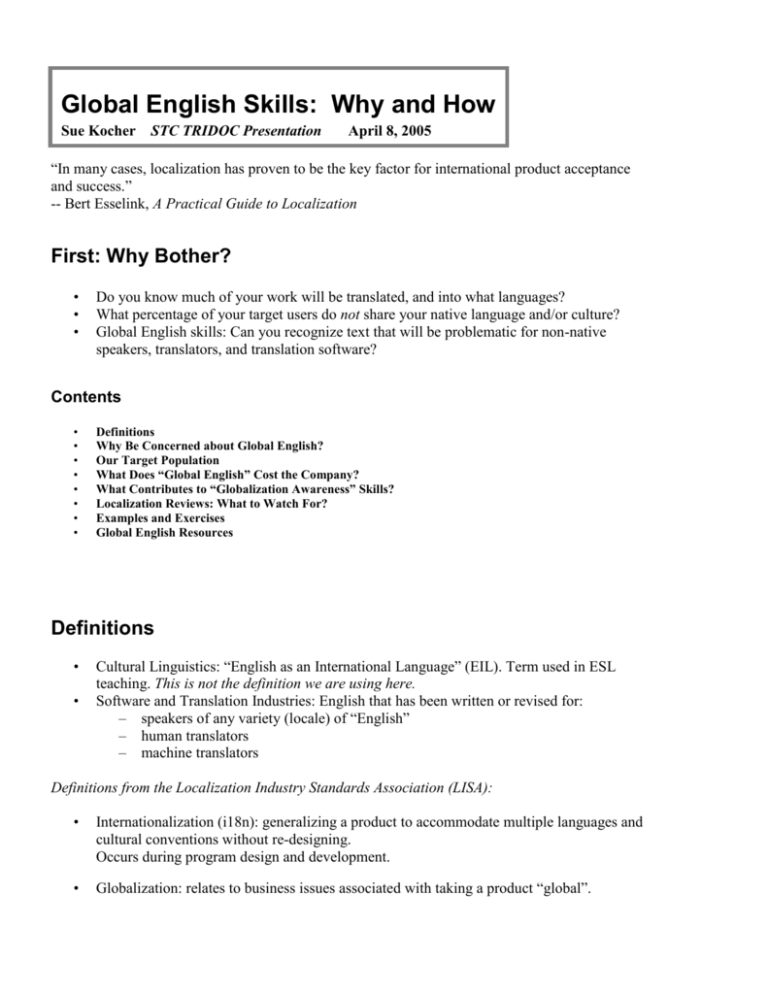
Global English Skills: Why and How Sue Kocher STC TRIDOC Presentation April 8, 2005 “In many cases, localization has proven to be the key factor for international product acceptance and success.” -- Bert Esselink, A Practical Guide to Localization First: Why Bother? • • • Do you know much of your work will be translated, and into what languages? What percentage of your target users do not share your native language and/or culture? Global English skills: Can you recognize text that will be problematic for non-native speakers, translators, and translation software? Contents • • • • • • • • Definitions Why Be Concerned about Global English? Our Target Population What Does “Global English” Cost the Company? What Contributes to “Globalization Awareness” Skills? Localization Reviews: What to Watch For? Examples and Exercises Global English Resources Definitions • • Cultural Linguistics: “English as an International Language” (EIL). Term used in ESL teaching. This is not the definition we are using here. Software and Translation Industries: English that has been written or revised for: – speakers of any variety (locale) of “English” – human translators – machine translators Definitions from the Localization Industry Standards Association (LISA): • Internationalization (i18n): generalizing a product to accommodate multiple languages and cultural conventions without re-designing. Occurs during program design and development. • Globalization: relates to business issues associated with taking a product “global”. Involves integrating localization throughout a company, after proper internationalization and product design, as well as marketing, sales, and support in the world market. • Localization(L10N ): translation and adaptation of a software or Web product (the application and all related documentation). “Global English Skills” relates to writing and developing for localization. Why Be Concerned about Global English? Relevant to: • Graphical User Interfaces • Documentation • Personal communication, both spoken and written: • among colleagues in a company with multi-cultural employees • between employees and customers (Sales, Tech Support, etc.) • Reasons for Acquiring Global Language Awareness #1: Your company, or target company, has clients who are not native speakers of your “locale” #2: Most users prefer to use software and doc in their own languages; some countries require by law #3: Global language awareness is a valuable, and therefore marketable, skill. #4: Cross-cultural awareness is useful and interesting (avoid cultural and linguistic imperialism) Our Target Population World population: 6,429,200,756 --as of 04/07/05 at 17:34 GMT US Population: --as of 04/07/05 at 17:3 4 GMT 295,828,675 Source: April 7, 2005, US Census Bureau, POPClock projections. http://www.census.gov/main/www/popclock.html • • • • • • Number of native speakers of English Number of people who speak English as a second language (ESL) Number of people who speak English as a foreign language (EFL) Percentage of people who use English with “some” level of competence Number of people who comprehend little or no English Number of people who have little or no knowledge of middle-class American culture, idioms, slang, symbols, customs, etc. 375,000,000* 375,000,000* 750,000,000* 20-25%* (1.3 –1.6 billion) 75-80% (4.8–5.1 billion) almost everyone in the world *according to the British Council What Does “Global English” Cost the Company? What It Costs NOT to Write for Translation Activity Uncontrolled Controlled, Single-sourced English dev’t of field definitions, revised from programmer’s specs to classroom texts, hardcopy doc, online doc $645 per field definition x 1000 definitions $260 per field definition x 1000 definitions Total: $645,000 Total: $260,000 Translation of 17 variations of 100 field definitions at .23 per word, etc. etc. $13,048,000 $770,000 What Contributes to “Globalization Awareness” Skills? 1. Required: Interest in cross-cultural communication and linguistics principles 2. Required: Objectivity • conscious effort to avoid cultural/linguistic bias • conscious effort to avoid getting attached to one’s own writing 3. Big help: Experience in learning a second language, preferably as an adult 4. Also helpful: Training in linguistics, experience living abroad as a ‘foreigner’, experience in translation or revision of documents written in a second language Localization Reviews: What to Watch For? • Terminology: Do words used in the GUI or doc have one meaning, and one meaning only? Is only one term used to express a specific meaning? • Usage: Recognize and eliminate slang and jargon. Consistency, not variety, is valued by users. • Grammar: Keep it simple! “Unpack” complex noun phrases and sentences. Simple stupid, incomplete, patronizing, or short. • UI design: industry standards, intuitiveness, consistency. Users need common tasks and UI functions to be predictable. Examples and Exercises GUI: Example 1 What’s wrong with this picture? Examples of Localization Issues in the GUI • • • • Terminology Usage Grammar UI Design GUI: Example 3 GUI: Example 2 What if the lead text does not seem to relate to the actual content of the window…. is that an NLS issue? ABC Server ? Verbing nouns weirds language! !!!!!! Documentation: Example 1 Examples of Localization Issues in the Documentation • • • • Terminology Usage Grammar Informational Design Documentation: Example 2 Adding a New Resource Template Resource templates are files defining the metadata requested by the Data Excavator when defining a certain type of object. Use the Add Resource Template Wizard to select the templates you wish to load. Documentation: Example 3 Select Additional Documents Window Short descriptions for language elements Use the Select Additional Documents window to choose documents assigned to other objects. The window contains Before: Determines whether character combinations are substituted for special characters that are not on the keyboard. Document Name lists the names of all other documents associated with other objects in the active repository. Another Field contains blah blah blah blah blah blah After: Specifies whether keyboard combinations are substituted for special characters that are not included on the keyboard. System Messages: Example 1 Examples of Localization Issues in System Messages • Terminology • Usage • Grammar String(s): chartCreationError.txt=•aChart component creation failure error... Translator: Is it failure or error? Developer: "creation failure" kind of error (Is this helpful? And will this be clear even to native English speakers?) System Messages: Example 2 String(s): FileNameHelp.txt=The name of the file that contains the logic. System Messages: Example 3 String(s): GanttChart.styleByError.txt=StyleByVariable ignored since LegendModel.setCatagories must also be set. Translator: What is the logic? Translator: What kind of thing are "StyleByVariable" and "LegendModel.setCatagories" Developer: logic is another way of saying the program that is run by the stored process. Developer: names of objects (A good example of developerese… but is it valid to assume that the user will understand this use of the term “logic”?) (Did anyone fix the spelling error in the source file? Also, “since” should be “because”…) Some Global English Resources • • • • • John Kohl’s Global English Guidelines (to be published) and Top Ten Global English Issues. Contact John.Kohl@sas.com Internationalising your English, by Richard Cook http://www.global-excellence.com/articles/text31.html Ask Oxford Plain English Guidelines http://www.askoxford.com/betterwriting/plainenglish/ activevoice/?view=uk How to write Global English: Some principles for clear writing http://www.audiencedialogue.org/english2.html From Plain English to Global English http://www.webpagecontent.com/corp_archive/139/5/ • • Microsoft Office XP Developer Localization Guidelines for Language and Terminology http://msdn.microsoft.com/library/ Microsoft Office XP Developer Localization Guidelines for Your User Interface http://msdn.microsoft.com/library/

